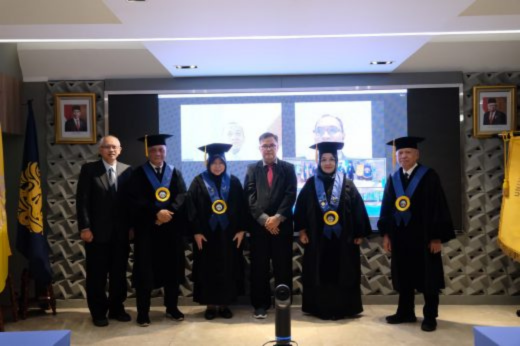Blockchain technology has traditionally been widely used in various industries but has limitations, such as scalability, high energy consumption, and long transaction processing times, especially when integrated with Internet of Things (IoT) devices. Lightweight blockchain tries to overcome this problem by introducing several new approaches, such as modifications or proposals to consensus, algorithms, or mining processes, that aim to reduce the computational complexity and energy consumption of blockchain networks.
The need to increase the integration of IoT technology with blockchain is the focus of Viddi Mardiansyah’s research in his dissertation entitled “New Data Structures Using a Cluster Mining Approach in the Integrated Lightweight Blockchain Framework of the Internet of Things”. Viddi presented his research findings at an open session for the promotion of a Doctorate in the Department of Electrical Engineering, FTUI (17/07).
Viddi’s research aims to overcome some of the limitations faced by traditional blockchain technologies, such as scalability, high energy consumption, and long transaction processing times, especially when integrated with IoT devices. To increase the capabilities of the lightweight blockchain, Viddi proposes two innovations in the form of a mining process using a cluster mining approach and a combined structure from Merkle, Patricia Trie, and Linked List.
“First, the mining process is implemented using a cluster mining approach whose level of difficulty can be adjusted using a leading-zero or count-zero approach. Second, Viddi combines the data structure of Merkle Patricia Trie with the Linked List to increase the ability to store information on the blockchain and ensure detailed information for the status of users of the current lightweight blockchain network,” said Viddi in his dissertation presentation.
In his research, Viddi focuses on the Proof of Work consensus algorithm that is commonly used in blockchain networks to increase the efficiency of transaction history searches on lightweight blockchain systems that are integrated with the Internet of Things. The results showed that the cluster mining approach can significantly reduce the mining processing time compared to the solo mining approach, especially at high levels of difficulty. In addition, the count-zero approach to searching for the target hash also provides a higher level of difficulty compared to leading-zero, with the same target hash search time of under one second.
These results were also proven through a trial of recording data on Sleep Apnea patients in an Android-based application to capture data from Oximeter devices using the leading-zero approach in searching for hash targets. In addition, using the combined structure of Merkle Patricia Trie and Linked List can provide increased speed performance in searching (querying or looking up) data history, which is very fast under conditions of varying amounts of transaction data compared to searching data history using the Merkle Tree. For storage media, the increase in the need for storage media is also considered quite small because, on average, the amount of storage media required is under 500 KB.
“Through experiments and implementation on a blockchain simulator, Viddi has succeeded in proving the efficiency and effectiveness of integrating IoT devices with a lightweight blockchain framework. This is certainly a new technological innovation that can be utilised and has a positive impact on blockchain development for IoT devices that have limited resources,” said Prof. Dr. Heri Hermansyah, S.T., M.Eng., IPU, Dean of the UI Faculty of Engineering (FTUI).
A research dissertation on the integration of IoT devices using a lightweight blockchain framework has succeeded in bringing Viddi Mardiansyah as the 162nd doctoral graduate of the Department of Electrical Engineering and the 513th doctorate of the Faculty of Engineering, Universitas Indonesia. The open session was chaired by Prof. Dr. Ing. Ir. Kalamullah Ramli, M.Eng., with promoter Prof. Dr. Ir. Riri Fitri Sari, MM., MSc., and co-promoter Dr. Abdul Muis, ST., M.Eng. While the examiner team consisted of Prof. Dr. Ir. Bagio Budiardjo, M.Sc., Prof. Dr. Ir. Anak Agung Putri Ratna, M.Eng., Dr. Muhammad Salman, ST., MIT; I Gde Dharma Nugraha, ST. MT. Ph.D.; and Prof. Alexandre Jlio Teixeira Santos.
***
Bureau of Public Communications
Faculty of Engineering, Universitas Indonesia

